Playing dress-up
100 years of costumes at UVA
Later this month, thousands of people—UVA students, Charlottesville children and their parents—will gather on the Lawn to trick-or-treat and show off their costumes. This tradition dates back to the 1980s, but costumes have been a part of student life for generations, through student societies, balls and parties, summer pageants and sports.
Gweneth West, a UVA drama professor and costume designer, teaches a class called History of Dress, which she says combines art history, sociology and economics. “Clothes are created by the culture that made them—they are an art. We are designing a persona every single morning when we get up and get dressed, whether we’re doing it consciously or not,” she says. “Costumes are an opportunity to express something you would never actually be. They create a way for us to literally hide behind a persona that we’re creating.”
Professor West helped Virginia Magazine take a look back at costumes at UVA through the years. Take a look below.

Summer Pageants and Plays
Although UVA did not become fully coed until 1970, women studied on Grounds during summer sessions, which started in 1907 through the UVA School of Education. The sessions, which satisfied requirements for teacher certification but did not lead to degrees, culminated in pageants and plays at the end of each summer. The University also held a pageant in 1921 to celebrate its centennial.

Summer Sessions pageant: participants from Nelson County, circa 1907
“They’re trying to mimic the period of Jefferson,” West says. “The dresses are meant to look like they’re from 100 years earlier but they have Edwardian corset belts [worn in the early 1900s]. The two men in the second row are “likely wearing actual garments that were worn by 1890s livery—they have a low-budget Downton Abbey kind of silhouette.” The man in the front row is costumed in something close to a Revolutionary War uniform, West says. “It looks like this could be somebody’s turn-of-the-late-18th-century garment that they’ve just had from their family.”
UVA Special Collections Library

Summer Sessions pageant: ladies of the Colonial Era, circa 1907
“These women are not poor,” West says. “They’ve probably spent a great deal of money to get somebody to make their costumes.” Once again, West says, although the women’s costumes are meant to look like Colonial garb, “the waists of these dresses are all very much like the clothes they’re wearing every day [in the early 20th century]. They’re not corseted in as tightly as they would have been 100 years before.” Their hair is also styled in a turn-of-the-20th-century style. “This is the way they wear their hair all the time,” she says.
UVA Special Collections Library

Summer Sessions Shakespeare productions, circa 1912
“Somebody in this troupe really loved the Russian ballet,” West says. “Léon Bakst was the designer for Sergei Diaghilev’s Ballets Russes, and he drew on images from the Greek and the Roman in terms of the silhouette line.” Each dress, she says, “is just one big piece of fabric with the top folded down.” Bakst painted a lot of the fabric for his ballet costumes. West imagines that the students in the picture “found out about Leon Bakst … and then they just laid the fabric out on the Lawn and they painted their own costumes.”
UVA Special Collections Library/Holsinger Collection

Centennial Pageant: Greek dancers in the amphitheater, 1921
Women dressed as Grecian dancers celebrate the University’s centennial anniversary in McIntire Amphitheatre. These costumes, West says, “were greatly influenced by Isadora Duncan [an early 20th-century American improvisational dancer]. The fabric is sheer, soft and fluid. These costumes were probably considered risqué.”
UVA Special Collections Library

Centennial Pageant, 1921
A pair of actors pose in UVA’s Centennial Pageant. The man in the photo is trying to look like he’s from the late 18th century, West says, especially with the use of the wig. His costume looks like it could be an original garment—possibly a master’s uniform at a boy’s academy she says. The woman’s dress features an empire waist that “is actually based on the Greek garment,” West says. “It then got revived in 1812, which got revived in 1912, which got revived in 1960, and was revived in 2015.”
UVA Special Collections Library/Underwood & Underwood

Summer Sessions pageants, circa 1938
Men with horse costumes gallop around the Lawn. “Those are typical hats and shirts and ties of the late 1930s,” West says. “I’m guessing these are a bunch of engineers.”
UVA Special Collections Library
Balls
The Beaux Arts Ball is an annual costume gala, hosted by the School of Architecture and Department of Art. It originated in the 1920s, named for the Beaux Arts tradition of architectural training” according to The University of Virginia: A Pictorial History by Susan Tyler Hitchcock. The Restoration Ball, sponsored by the Jefferson Society and the University Guide Service, began in the early ’60s as way for students to raise money for the restoration of the Academical Village.

Beaux Arts Ball, group shot, circa 1920s
Ball attendees are captured from above. “If I were to make a general statement about what the Beaux Arts Ball is about,” West says, “I’d say it’s giving yourself permission like you’ve never received before. Nobody’s going to judge you or criticize you.”
UVA Special Collections Library

Beaux Arts Ball: Al Johnson (undated)
From the original photo caption: “Al Johnson and Lion.”
UVA Special Collections Library

Beaux Arts Ball, circa 1952
From the original photo caption: “One of the couples attending the recent Beaux Arts Ball at the University [is] shown above. The Ball, once an annual tradition of the University’s school of art and architecture, was the first held at the University since 1928. Shown are Mr. and Mrs. Don S. Carpenter, North Merrick, NY.”
UVA Special Collections Library

Beaux Arts Ball, “Most Beautiful” circa 1952
From the original photo caption: “Shown above is one of the couples attending the Beaux Arts Ball held recently in the Fine Arts Museum at the University of Virginia. The Ball revived what was once an annual tradition of the University’s school of art and architecture. Shown are Mr. and Mrs. Howard Besosa, San Juan, Puerto Rico, whose costumes were judged ‘most beautiful’ at the ball.”
UVA Special Collections Library

Beaux Arts Ball, 1952
An array of costumes (including robots) from the 1952 Beaux Arts Ball
Corks & Curls

Beaux Arts Ball, 1976
A selection of costumes (including The Wizard of Oz’s Tin Man and Cowardly Lion) from the 1976 Beaux Arts Ball
Corks & Curls

Beaux Arts Ball, 1978
The 1978 Beaux Arts Ball seemed to have an oceanic theme.
Corks & Curls
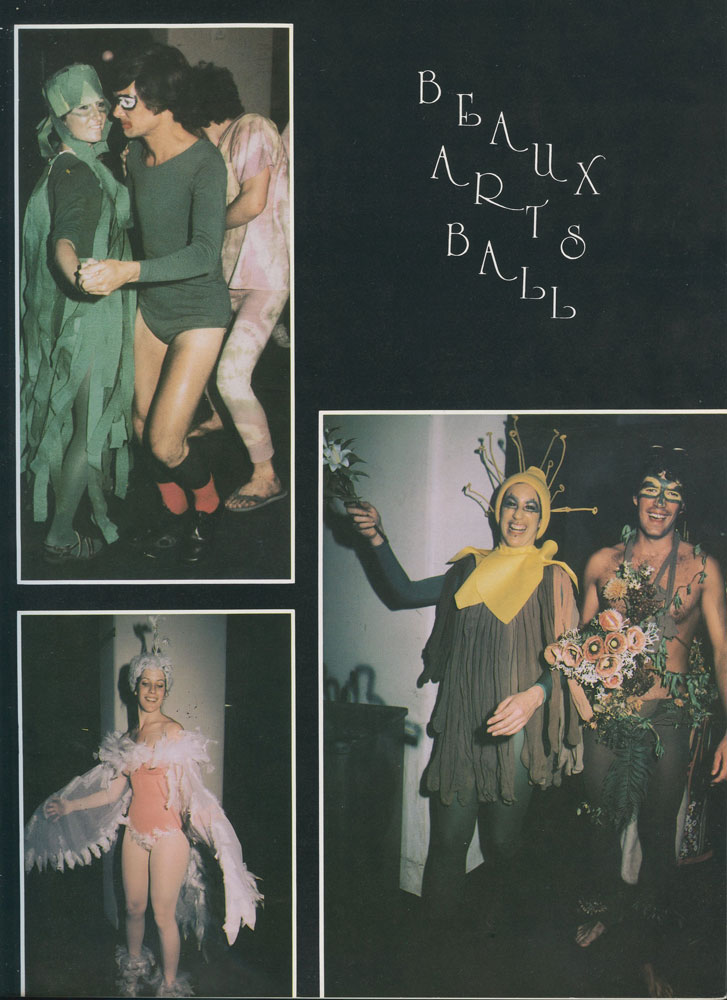
Beaux Arts Ball, 1979
1979 Beaux Arts attendees went back to nature.
Corks & Curls
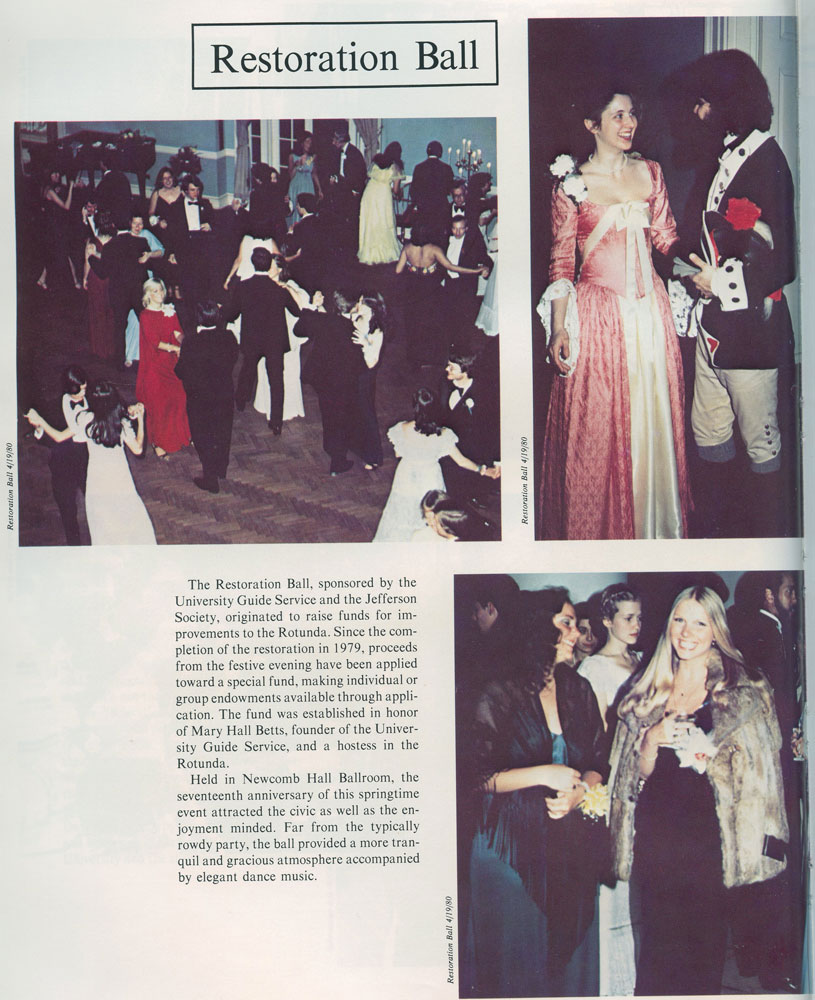
Restoration Ball, 1980
In contrast with the Beaux Arts Ball, West says, the Restoration Ball fashion is about “getting close to the University’s history. The [students] want to look perfect.” Attendees wore everything from modern furs to Colonial-era garb.
Corks & Curls

Restoration Ball, 1981
“Somehow I feel carried back in time, to a period of the Old South,” writes a Corks & Curls author.
Corks & Curls
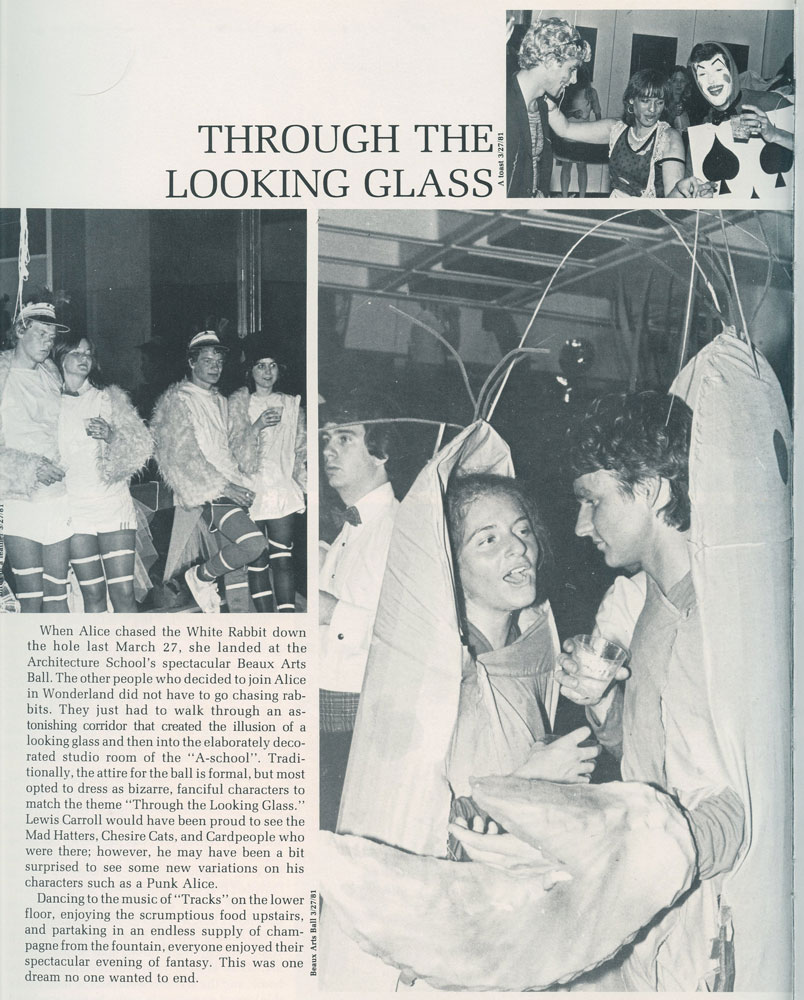
Beaux Arts Ball, 1982
The theme was “Through the Looking Glass.”
Corks & Curls

Restoration Ball, 1982
“For some it seems a step out of time, for others, a ‘politico showcase,’ for even more, merely an excuse to shed their blue jeans and pretend,” wrote Corks & Curls.
Corks & Curls

Beaux Arts Ball, 1986
From the Corks & Curls caption: “Expressing the paradox of weapons designed to ‘keep the peace,’ Jay Minnix (Engr ’84, ’86) and the masked Mary McClarnon (Engr ’85, ’90) refuse to let the gravity of their social statement dampen their evening.”
Corks & Curls
Student Societies & Parties
It’s impossible to find photos of 7 Society members, but ring societies, such as the IMPs, pose for annual photos in costume. Other student groups, such as the UGuides, throw themed costume parties. And certain organizations, such as the Society for Creative Anachronism, are dedicated to dressing in medieval costumes and “assuming appropriate personae.”

IMP Society, circa 1925
Members of the 1925-1926 IMP Society pose in robes and devil’s horns. The organization was formed in 1902 as the Hot Foot Society and reconstituted in 1913 as IMPs. IMP is an acronym for Incarnate Memories Prevail.
UVA Special Collections Library/Holsinger Collection

IMP Society, circa 1955
Each member of the 1955 IMP Society had his own pitchfork.
Alumni Association archives

Students in 1970: costumes or clothes?
Students socialize on the Lawn in 1970. It’s unclear whether they are in costume. “I think that these are regular outfits,” West says. “But I imagine they bought them somewhere. When they saw these clothes, they said, ‘I can’t even believe these even exist! I’m buying them.’”
Corks & Curls

Lawn Chowder and Marching Society, 1976
The Lawn Chowder and Marching Society originated in the early 1900s with the West Lawn Chowder Society and rival East Lawn Chowder Society. The Virginia Pep Band claims to have its roots in the East Lawn Chowder Society’s band. According to UVA historian Sandy Gilliam, the societies fell dormant until 1955 when Lawn resident Ben Phipps (Col ’55, Law ’58) revived them as one Lawn Chowder and Marching Society. According to Gilliam, the society, made up solely of Lawn residents, does little else than pose for a picture in costumes.
Corks & Curls

The Society for Creative Anachronism, 1976
UVA’s chapter of the national group the Society for Creative Anachronism “seeks to recreate the Middle Ages as they should have been, rather than as they were,” according to the Corks & Curls caption.
Corks & Curls

The Society for Creative Anachronism, 1978
According to Corks & Curls, society members “participate in tournaments, contests of skill and chance, intellectual discussions, music, dance, feasting and general revelry,” all while “dressing in in period costumes and assuming appropriate personae.”
Corks & Curls
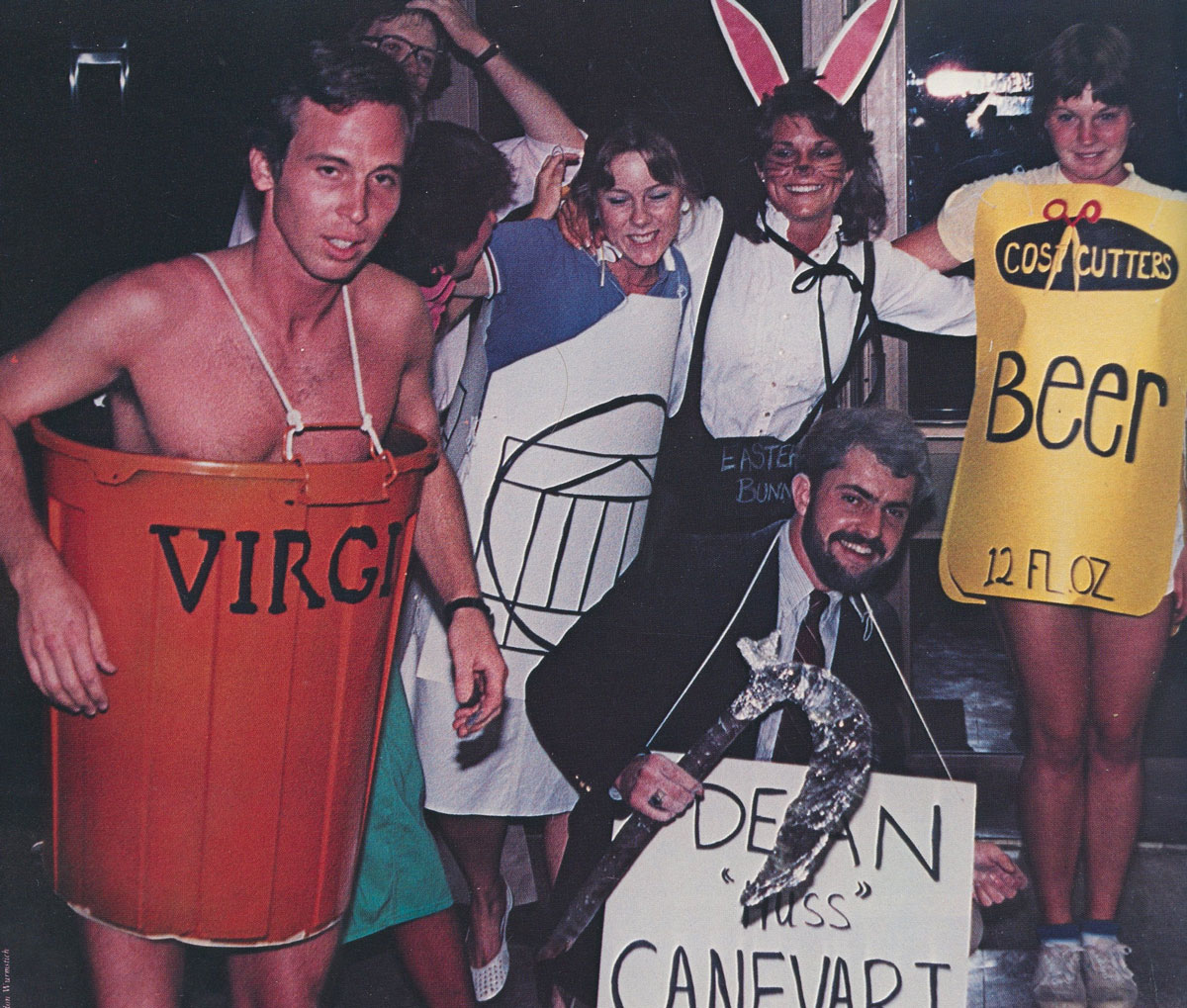
Resident Staff party, 1984
From the Corks & Curls caption: “[At] their annual costume party, Resident Staff members from Kent gather in Lambeth Commons. This year’s party, held on August 26, was billed ‘History of the World, Part III.’”
Corks & Curls

IMP Society, 1985
From the Corks & Curls caption: “IMPs regroup before setting out to make a traditional Openings weekend tapping.”
Corks & Curls

University Guides Tacky Tourist Party, 1985
From the Corks & Curls caption: “Tacky tourists? Not really—just members of UGuides showing off their finest polyester and groovy dance steps during their annual Tacky Tourist Party on the Lawn.”
Corks & Curls

Bahamas Party, 1985
From the Corks & Curls caption: “One celebrator enjoys the usual beverage and the music of Sunfire at last year’s Bahamas Party.”
Corks & Curls

University Guides Tacky Tourist Party, 1988
University Guides pose for a photo at their annual Tacky Tourist party on the Lawn.
Alumni Association archives
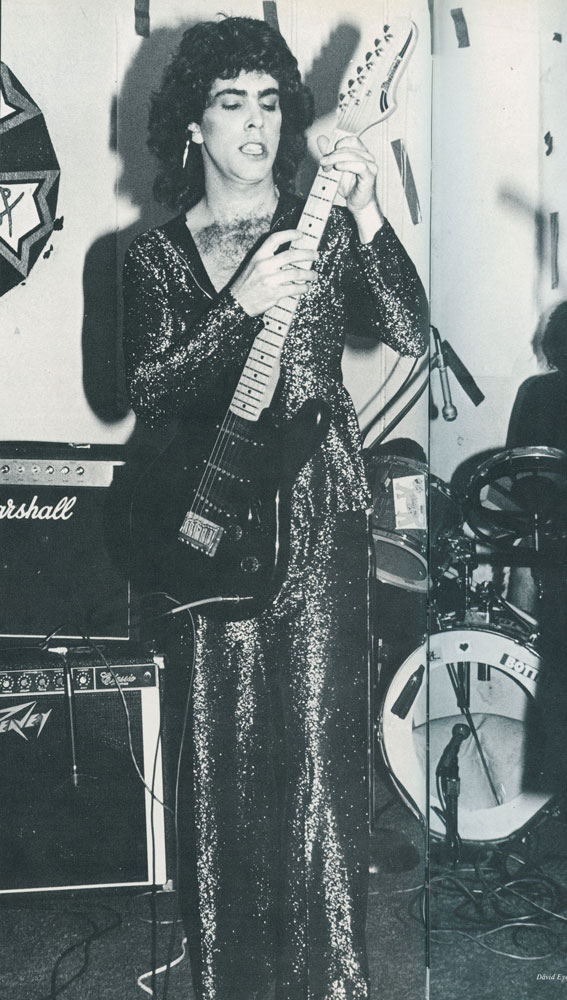
Graduate Student Band, 1988
Aaron Margosis (Col ’83, Engr ’88) performs in his band, Zero Kings, in a costume “reminiscent of Gene Simmons,” according to Corks & Curls.
Corks & Curls

Madrigal Dinner, 1989
From the Corks & Curls caption: “Yong In Kim (Col ’92) and Hyun-Joo [Ellen] Rim (Col ’92) converse with one of the patrons of the Madrigal Dinner. Held every winter, the Madrigal Dinner brings together the efforts of many on-Grounds organizations such as the University Singers, the Fencing Club and the Juggling Club to entertain the enthusiastic audience.”
Corks & Curls
Greek Parties
These photos are just a sampling of themed parties from the 1960s through the ’80s. Fraternities tend to be known more for their socializing than creativity, but one group photo from 1971 caught Professor West’s eye because “every single person is so focused on being in character.”
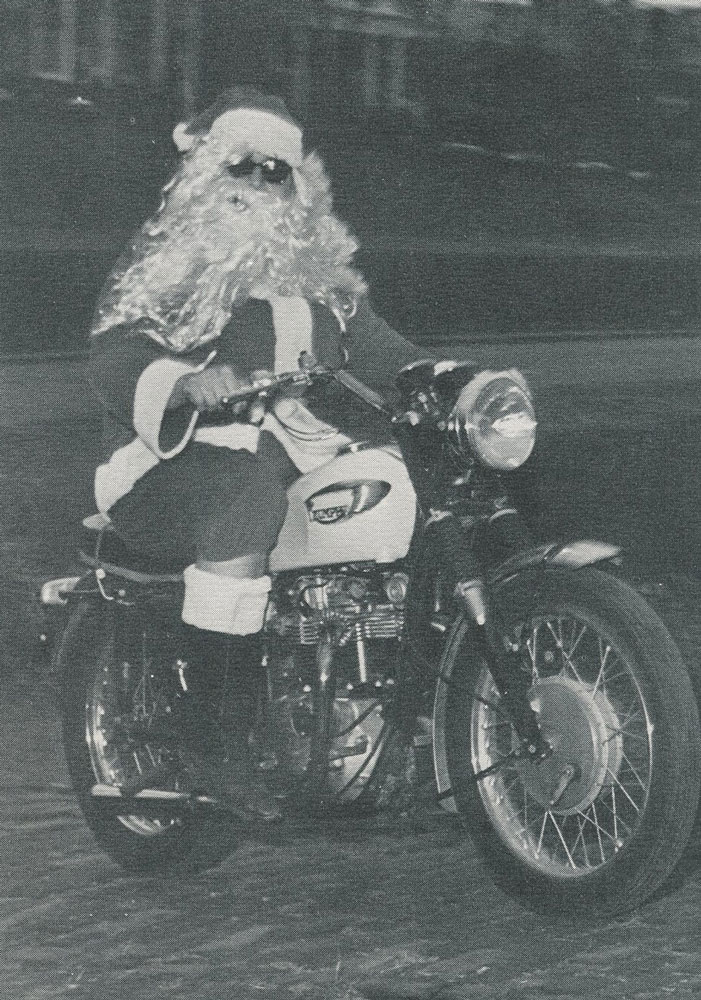
Santa, 1967
This motorcycle-riding Santa Claus was part of the fraternity page for AEKΔB (Kappa Sig).
Corks & Curls

Pi Gamma Delta, 1971
A cone head at a Pi Gamma Delta fraternity party
Corks & Curls

Sigma Chi, 1971
Professor West notes the various characters being portrayed in this photo—“pioneers, hobos, Wyatt Earp, Marlon Brando and Jack Kerouac-types.” She also notes the asymmetrical composition. “Whoever posed the photo also is a fabulous artist,” she says. Sigma Chi alumnus Steve Walther (Com ’71) was the son of an Eastman Kodak researcher, and as such “was very interested in photography from an early age and brought that to Virginia.” He served as the historian for the Psi Chapter of the fraternity at UVA from 1968-71 and was responsible for setting up and taking this photo under Beta Bridge. According to Walther: “I was very familiar with the bridge, so I got the idea to stage the photo … with a tripod—luckily, trains were infrequent!” John Thiel (Col ’71), the “shotgun-toting guy in the center, sporting a top hat,” explained the theme: “Butch Cassidy & the Sundance Kid (Paul Newman, Robert Redford) was a very popular, Academy Award-winning movie in 1969. Taken from a true story, their bank-robbing crew was called ‘The Hole in the Wall Gang.’ We adopted its good-guys-as-bad-guys theme, a poke at the … clean-cut, frat boy photos that had been the norm at UVA for decades.”
Corks & Curls
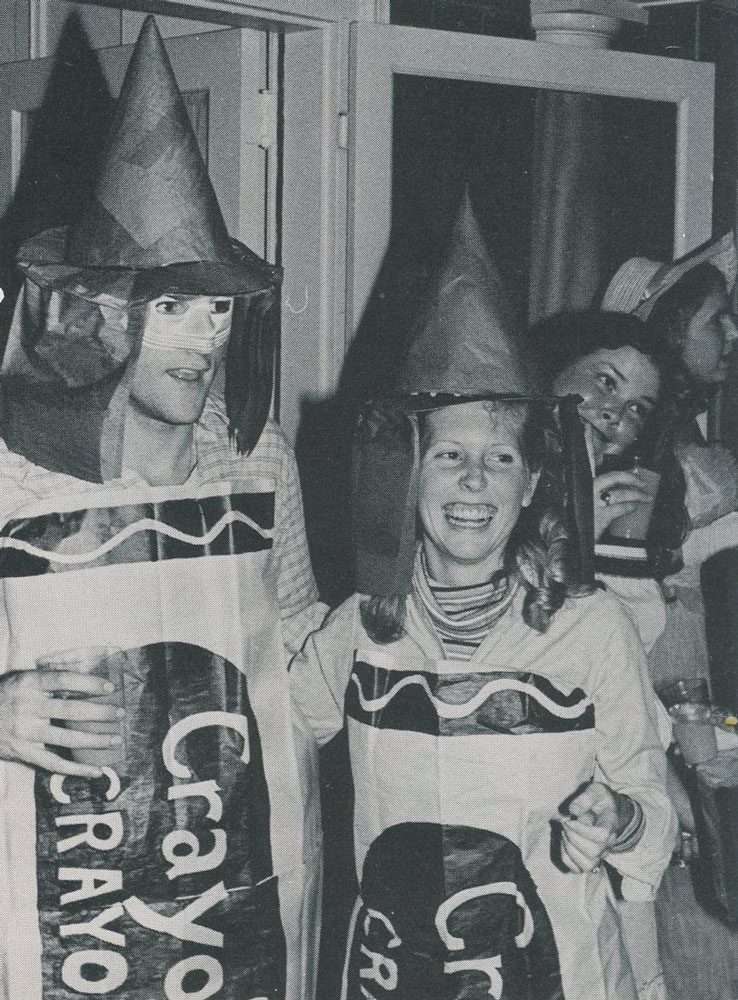
ZTA, 1979
The women of Zeta Tau Alpha sorority featured this Crayola couple on their yearbook page.
Corks & Curls

Banana, 1983
According to the Corks & Curls caption: “Tim Dowling and Charlotte S. Woody (Col ’86) ‘Going Bananas’ at the Tri-Delt Jamaica Party in February of 1983.”
Corks & Curls

Square Dance, 1985
Katie Howard (Col ’86) and her date form the arch for Delphine Chang (Col ’85) and her date as Zeta Tau Alpha sisters “enjoyed an old-fashioned, foot-stomping good time” at their hoedown, writes Corks & Curls. According to Ms. Chang (now Mrs. Ferenczy), “whether it was through a sorority or another club/activity affiliation, there was always something fun to look forward to at Virginia. And the set-up and planning were all part of the fun…creative students on limited budgets throwing tremendous theme parties!”
Corks & Curls

Fiji Party, 1986
Fiji brothers John Payne (Col ’87) and Andy Volin (Col ’86, Law ’89) flashed their legs at the annual Phi Gamma Delta Halloween Party on October 24, 1985, according to Corks & Curls. The fraternity, composed of mostly Jefferson and Echols Scholars, also directed much of their energy into community service programs such as Big Siblings, Handicapped Services and other initiatives of Madison House.
Corks & Curls

Trekkies, 1987
Joe Atkins (Arch ’88, ’92), Ahroon “Tooney” Henderson (Com ’88) and Kyle Colclough (Engr ’89) enjoy the Sigma Chi-Pi Phi Halloween mixer “Trekkie style” in 1987, 20 years after the original Star Trek series aired on NBC.
Corks & Curls
All Hallow’s Eve
Halloween costumes on Grounds from the 1970s to 2015

PBR cans, 1970
Students dressed as cans of Pabst Blue Ribbon
Corks & Curls
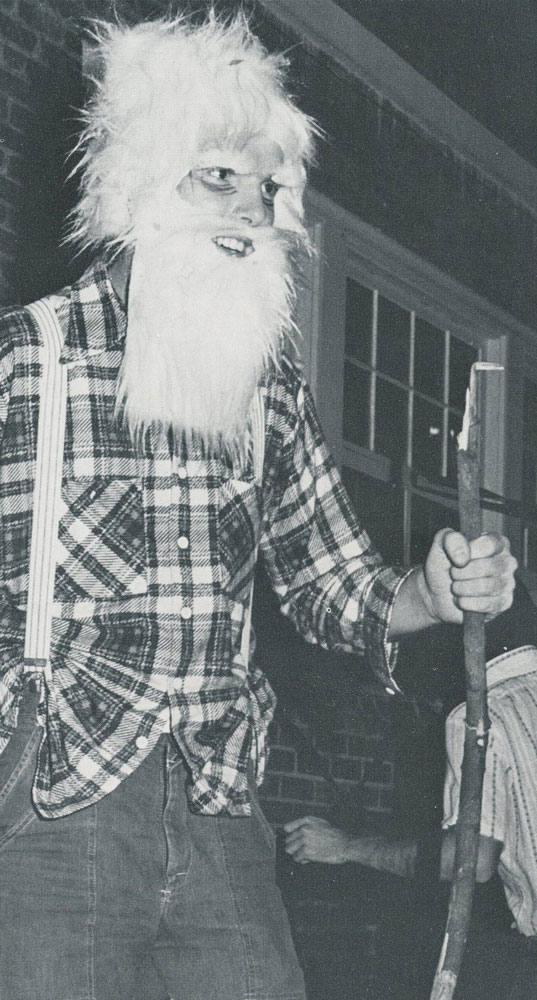
Halloween, 1975
A student dresses as a mountain man
Corks & Curls

Halloween, 1975
A student dressed as Groucho Marx perches on a railing. Groucho Marx was still alive in 1975 (he died in 1977); in 1974, he won an honorary Academy Award.
Corks & Curls
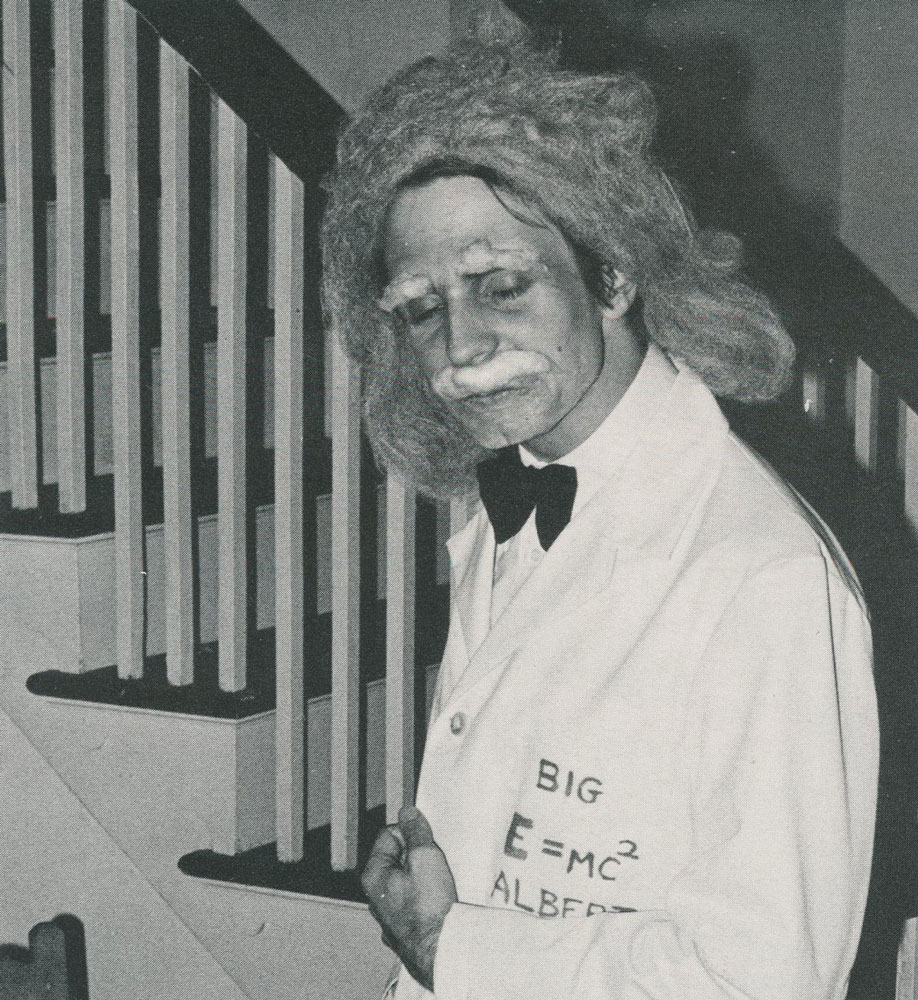
Fright Night, 1978
A student dressed as Albert Einstein
Corks & Curls

Fright Night, 1978
A student wears a mask and Chevrolet cap
Corks & Curls

Fright Night, 1978
A student shows off her fangs
Corks & Curls

Fright Night, 1978
A student dressed as Raggedy Ann. The Raggedy Ann character originated in the early 20th century and had a resurgence in popularity in 1977 with the release of the film Raggedy Ann & Andy: A Musical Adventure.
Corks & Curls

Halloween on the Lawn, 1992
In a tradition started by students in the late 1980s, local parents bring their children trick-or-treating on the Lawn for Halloween. Lawn residents often dress up to spend the evening handing out sweets, and secret societies often help out with paying for candy.
UVA Special Collections Library/UVA Today
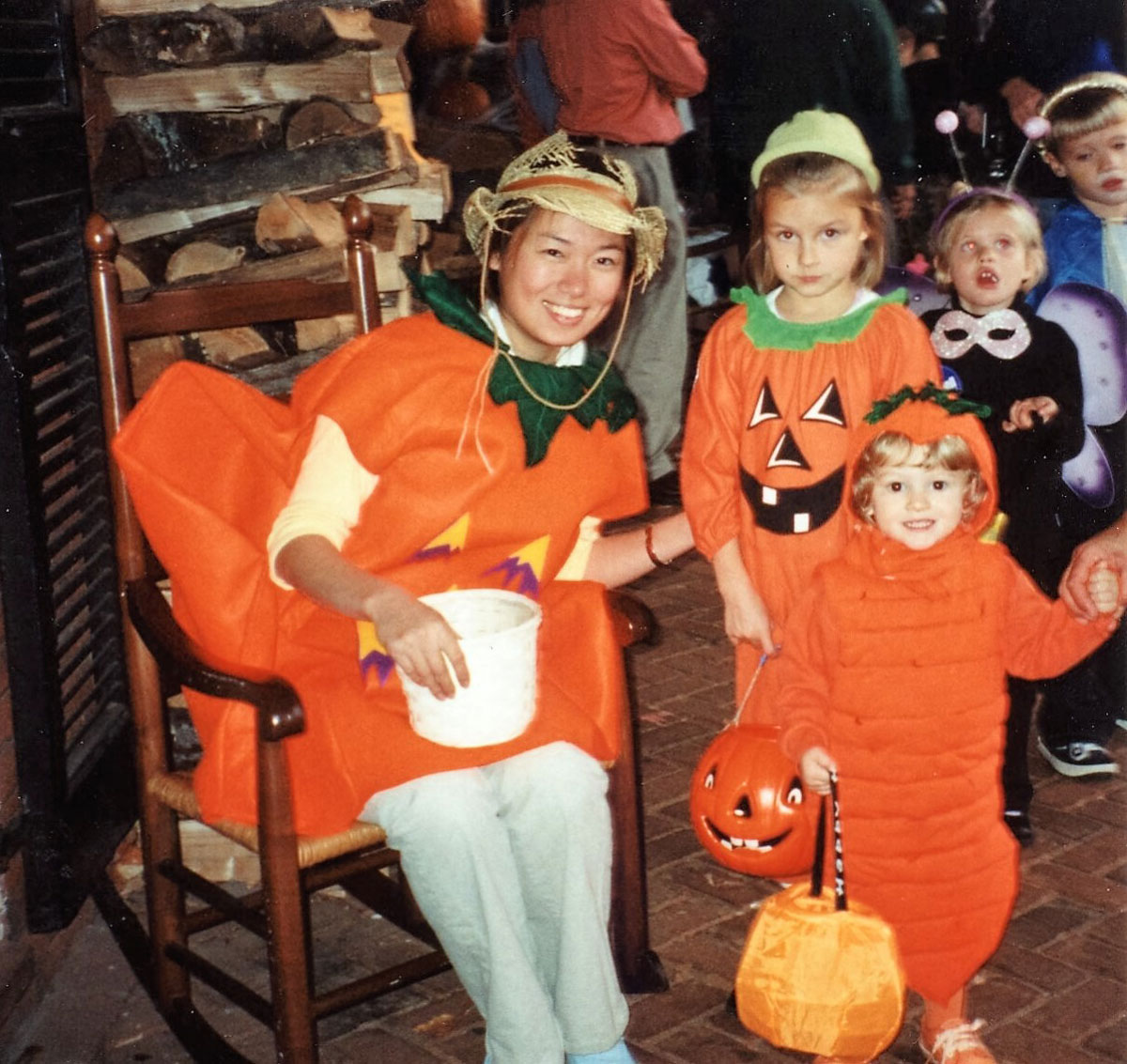
Halloween on the Lawn, 2001
These brightly colored pumpkins found their match at the room of a Lawn resident.
UVA Special Collections Library/UVA Today

Halloween on the Lawn, 2015
Buzz Lightyear and a ship full of Vikings join the crowd of children trick-or-treating on the Lawn.
Kathleen Herring photo

Pumpkin Spice Latte, 2015
According to Professor West, people choose clothes that show their affinity to celebrities or trends, “so the clothes we choose actually reflect not only who we are, but also our perception of the world.” This student’s 2015 Pumpkin Spice Latte came complete with scented orange paint and a hand-drawn Starbucks-logo cup sleeve.
Kathleen Herring photo
Mascots
A look at the evolution of Cavman, as well as little-known mascots who only made brief appearances at athletic events.

Cavman, 1967
A 1933 ad in the Washington Post featured a caricature of the “Virginia Cavalier” fighting a VMI cadet. The Cavalier was shown with a moustache and boots, widely cuffed pants, a jacket and long gloves, a feather stuck into a wide-brimmed hat, with a drawn sabre. This was the inspiration for the costumed figure shown here in 1967.
Corks & Curls
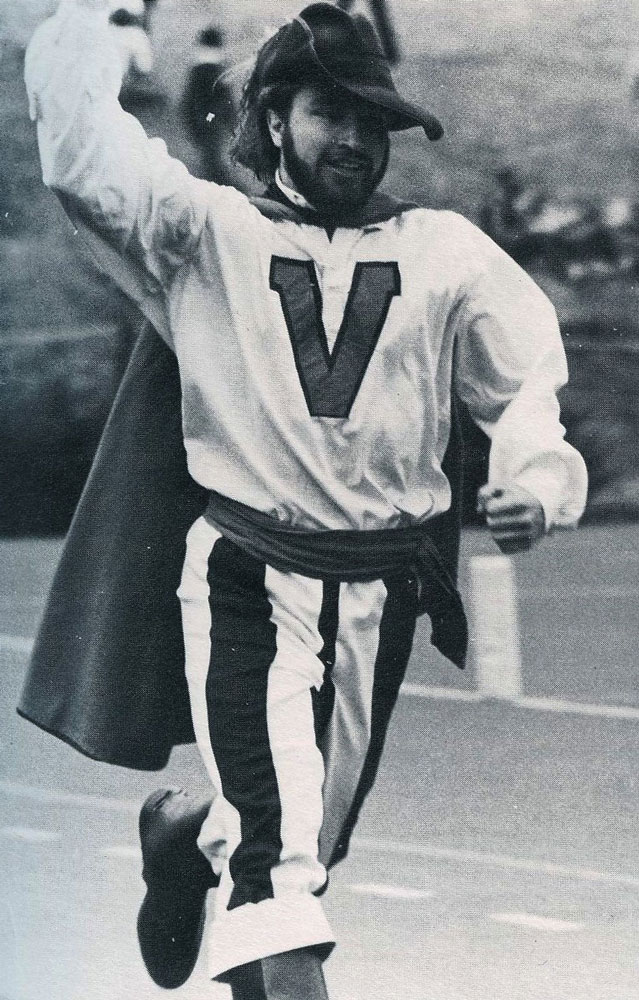
Cavman, 1981
By the early ’80s, The Cavalier had taken on the ‘V’ logo and a superhero’s cape, but the overall look was the same.
Corks & Curls
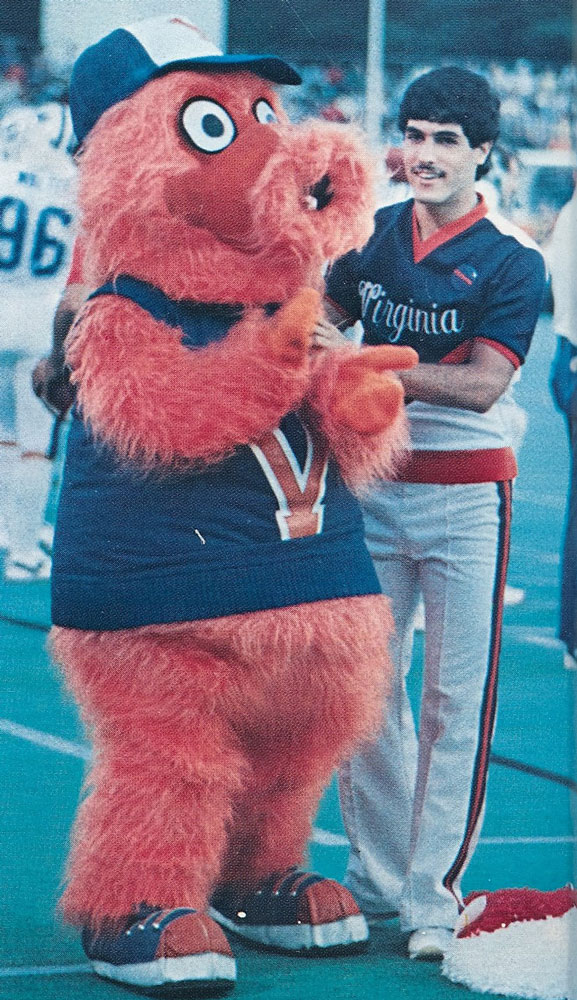
New Hoo, 1984
In 1984, the athletic department introduced the furry, bright orange Hoo as UVA’s new mascot.
Corks & Curls

New Hoo, 1984
Students protested the change, complaining that the cartoon-like character did not adequately represent the University and that they had no say in the mascot’s selection.
Corks & Curls

New Hoo, 1984
After only two appearances, the Hoo was retired, though not before this humorous “fight” with the pep band’s “What” mascot.
Corks & Curls
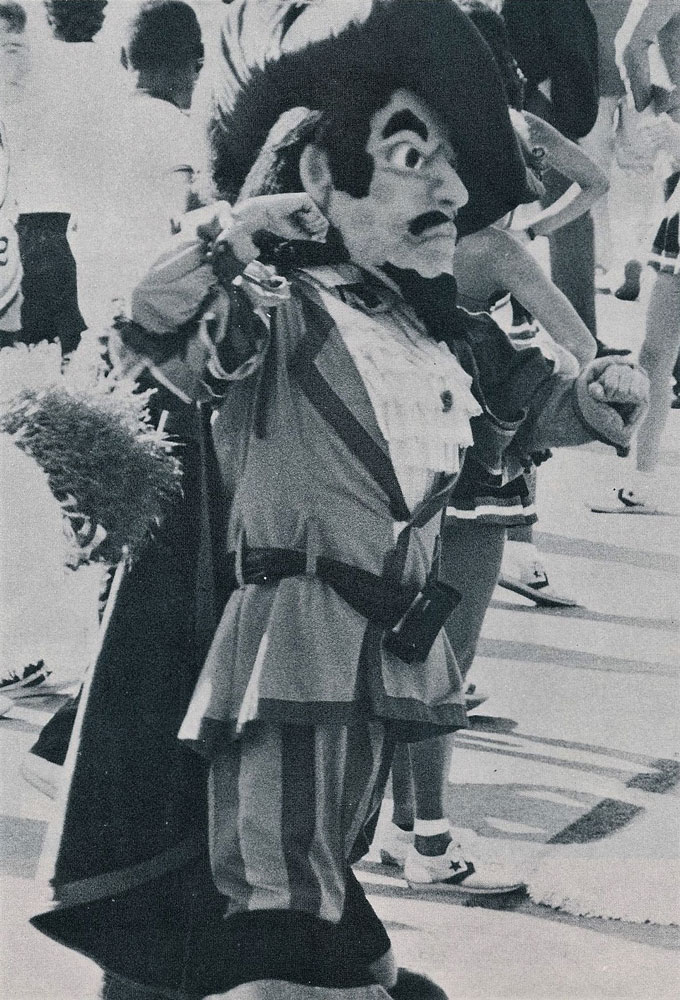
New Cavman, 1985
After the protested unveiling of the previous year’s mascot, the University returned to the traditional Cavalier, this time accompanied by a dog. Beneath the mascot’s new head, the Cavman actor gained anonymity.
Corks & Curls

U. Union Man, 1985
Created in 1985 by the resource committee of University Union, U. Union Man’s purpose was “to increase student enthusiasm and awareness of events sponsored by University Union,” according to Corks & Curls. Sporting blue tights, orange-and-white striped shorts and an orange cape, U. Union Man was popular at events such as Grad Happy Hour and short-course registration.
Corks & Curls

Cavman, 1989
Student Chris Dey (Col ’89) is pictured here as Cavman at a football game.
Corks & Curls